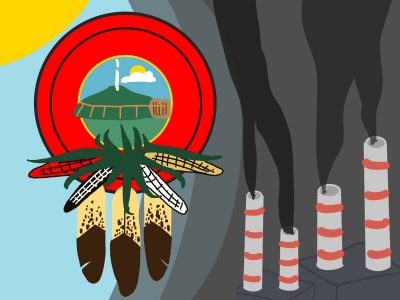Fossil fuels bring more harm to our planet than giving off 89% of global CO2 emissions. The harvesting of these resources damages the environmental health of Indigenous communities. Poor environmental health inevitably leads to negative effects on physical, mental and emotional health, and we must call United States leaders to action so Indigenous people do not suffer in silence.
Natural resources are found on tribal lands, such as oil to coal. Ignorant with greed, companies march through Indigenous lands hoping to get to the resources, not giving a second thought to the communities they are destroying.
Kandi White — a woman who grew up on the Fort Bethold Indian Reservation in North Dakota — recalls living with bright blue drinking water after an oil spill near the Reservation, and the stench of gas flares from fracking. White was diagnosed with a stage four sarcoma tumor when she was just 20 years old, and all she could think was “now it’s my turn,” as many people in her community had cancer. Indigenous people are at increased risk of developing chronic illnesses like cancer, cardiovascular diseases, diabetes and respiratory diseases.
Radon —a gas emitted from the radioactive decay of elements like uranium — can rise to dangerously high levels inside homes, increasing the risk of pulmonary diseases. There is concern over radon emissions in Indigenous communities, as the extraction of uranium is sought out by companies seeking more natural resources. Children of Indigenous descent are 60% more likely to be diagnosed with asthma than white and non-Hispanic children, and lung cancer is a leading cause of death in Indigenous communities.
Given the serious health risks associated with radon exposure, radon mitigation is essential in reducing its presence in homes and buildings. Implementing proper mitigation techniques, such as ventilation systems and soil depressurization, can significantly lower radon levels and help protect vulnerable populations from long-term health complications. Increased awareness and proactive mitigation efforts are critical in ensuring safer indoor air quality, particularly in communities at higher risk.
Indigenous communities are speaking up about the negative impacts of fossil fuel sourcing on their physical health, but also on their emotions, cultures and sacred spaces. The Dakota Access Pipeline — halted by the Obama administration, but forced to completion by the Trump administration — now poses a problem for the Lakota and Dakota peoples. Oil is flowing beneath Lake Oahe — the primary water source for these groups. This demonstrates a clear danger for Indigenous communities who want the right to their land and the privilege to not worry about what is in their water.

The fight for climate justice goes hand-in-hand with the fight for Indiginous rights. A recent report by NDN Collective — a nonprofit Indigenous organization committed to bringing environmental and social justice to their communities and the world around them — discusses the legal and environmental violations committed by the Dakota Access Pipeline’s leading company, Energy Transfer, and members of the federal government. Not only does the Pipeline ignore the requests and health of Indigenous peoples, it also maintains faulty infrastructure that will have devastating environmental impacts.
Members of Indigenous communities have been highlighting these issues for years. Public health researchers are helping defend Indigenous rights by calling out institutions responsible for destruction and writing reports about the negative impact of fossil fuels on these communities. The Harvard T.H. Chan School of Public Health recently hosted a panel of experts on Indigenous rights, environments and health concerns pertaining to fossil fuels. Universities must host more discussions on Indigenous rights activism — and demonstrate their dedication to improving the lives and environments of Indigenous communities through action rather than sitting behind their words.
Indigenous communities often lead efforts to act on environmental sustainability. Longing to preserve biodiversity and the land of the original U.S. peoples, Indigenous leaders are collaborating with nonprofit organizations and environmental protection agencies to bring environmental, legal and social justice to their homelands. Maintaining climate safety positively impacts the health and well-being of the communities suffering from environmental damage.
Efforts to preserve land, wildlife and ecosystems can be seen across Northern America, from tribes in Canada to tribes in the U.S. Indigenous Protected and Conserved Areas are used to protect Indigenous land, but have also contributed to protecting other climate-critical locations. Preserving clean water has become a primary focus in the attempt to keep healthy and stable environments for Indigenous people — something pipeline construction completely devastates.
Preserving biodiversity and allowing for multicultural equity should be at the top of each of our priority lists. Acquiring fossil fuels must not come before saving the lives and cultures of Indigenous people, nor the abundance of life occupying the rest of our planet.






















































































































